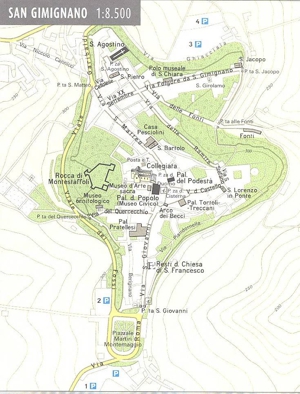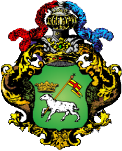|
|
San Gimignano, on a hill of 324m between the Val d'Elsa and the Val d'Era, already home to ancient Etruscan settlements from the most ancient period to the late imperial age. Important passage on the Roman via Clodia and the still oldest Via Francigena, San Gimignano has always played an important role in the military-strategic field. It was under Volterra, then exploiting the wealth of trade and the geographical position, had a strong development already in the tenth century .. The first nucleus was born on the Poggio della Torre, former residence of the Bishop of Volterra and Poggio di Montestaffoli where it was built powerful rock. The open hostilities against Volterra began in 1130 and about 20 years later San Gimignano was practically autonomous. The city immediately allied with F.nze against Poggibonsi and Colle val d'Elsa. In 1207 the new city walls were built (incorporating the villages of S. Matteo, and S. Giovanni), of which there are still three gates: the arch of Goro (N), the arch de 'Becci (E), the stone arches of St. Matthew (W).
In 1229 the rich mercantile commune, was still with F.nze consolidating the alliance. In this period the towers seem to be 72, today there are 14 perfectly intact. In 1251 S. Giovanni built the II walls and incorporated the new districts including Montestaffoli with the two main gates on the Francigena: San Giovanni and San Matteo built in 1262, and two other secondary buildings of Quercecchio and San Jacopo. These walls were tall and thick with hard stone coming from the nearby quarry of Pecille, interspersed with square towers to consolidate some stretches and from hollow towers in other points already naturally defended. This wall is now almost complete with all its original gates. Between the 13th and 14th centuries. reached its maximum splendor, then a series of internal struggles between the Salvucci and Ardinghelli families caused their total submission to Florence in 1353.
The fortifications were further increased: a new fortress, a high tower, 2 square towers; then again in 1470 added 5 bastioned circular towers. It did not last long. After the fall of Siena in 1555 the fortress and many other structures were demolished. To be seen. Palazzo Comunale: Courtyard and Hall of Dante. Civic Museum and Art Gallery. Basilica of Santa Maria Assunta and Chapel of Santa Fina. Archaeological Museum. Church of San Agostino.C.Il of San Bartolo. Museum of Sacred Art, Ornithological Museum and Hall of St. Francis.
Churches of San Gimignano
* Collegiate Church.
It is in practice the Cathedral of San Gimignano and was completed in 1148. Considered one of the greatest expressions of the Tuscan Romanesque style. It has three naves whose interior is completely frescoed. The "Stories of Santa Fina" by Domenico Ghirlandaio and the "San Sebastiano" by Benozzo Gozzoli are particularly relevant. Among the Sienese school painters is Bartolo Fredi the "Old and the New Testament". The "Last Judgment" is instead Taddeo Bartolo. Among the sculptures are the "Annunciation" on wood by Jacopo della Quercia and on marble the works of Giuliano and Benedetto da Maiano.
Loggia del Battistero (Oratory of San Giovanni)
It is located on the left side of the Collegiata and remained so until 1632 when it closed and turned into an oratory. Thanks to this transformation, the internal wall could be frescoed by masters such as Domenico Girlandaio, Giuliano di Martino Cetti and Sebastiano Mainardi. After being also a baptistery when the source of 1379, the work of Giovanni di Cecco was leased, it was then reported to the use for which it was built by demolishing the walls that closed the lights of the columns. Frescoes today are visible from the outside.
* Church of Sant'Agostino.
Also this church contains numerous frescoes, in particular the Chapel of Saint Bartolo (Benedetto da Maiano), Stories of the life of Saint Augustine of (Benozzo Gozzoli), and other remains of frescoes, tables and paintings by different authors (Benozzo Gozzoli, Piero of Pollaiolo, Pier Francesco Fiorentino, Vincenzo Tamagni, Sebastiano Mainardi).
* Pieve di Santa Maria
Located in the locality Cellole, in the municipality of San Gimignano it is part of the Diocese of Volterra. The first news is in 1109, underwent several reconstructions between the twelfth and thirteenth centuries, and then consecrated in 1238. It has three naves ending in a semicircular apse. The interior decorations are composed of lunettes with the typical motifs of the Val d'Elsa, placed in a series of blind arches. Inside, it is also worth noting the baptismal font in travertine that has remains of frescoes representing the saints and dating back to 1300. The façade was restored in the twenties and is decorated with travertine beams.
* Sanctuary of "Maria Santissima Madre della Divina Provvidenza".
Probably in the period between 1475 and 1499, Pier Francesco Fiorentino painted a newsstand with the image of Mary feeding the sacred child. Over the years the newsstand and the fresco were forgotten. Neglecting it, the newsstand was soon covered of brambles and plants. At the same time, across the valley underwent a period of severe poverty due to prolonged drought. It is said that in April 1668, Bartolomea Ghini, a mute woman from her birth, was around grazing their sheep. On that day she began to cry thinking about her social condition and extreme poverty even to her poor conditions in which he was reduced. In that juncture, the shepherdess saw a beautiful Lady which asked her the reasons for the tears. The shepherdess was ableto respond and the Lady said to go home that she shall find the pantry full of bread, the orci filled with oil and wine cellar barrels, filled with wine. At that time Bartolomea realized that she spoke she run to her house screaming joy. The parents realized that a miracle happend: their daughter could speak the house was full of food. They heard directly by Bartolomea the story of that special day. Obviously the news was really fast to reach all the farer corners of the land. and all the pastors of the area went in the same spot with the hope of meeting the woman to get as well, something to eat. They only found but only a heap of brambles so they decided that remove them to see what was underneath. Today the scratch of roncole still marks the holy image. when they found the painting they found out as well who was the Lady Bartolomea meet before! They decided to name it as "Mary Mother of divine providence". Later the spread of double miracle, the area was filled with pilgrims and in just two years, the newsstand arosed around the sanctuary (1670). In 1923, with some delay century, the church was a high-sanctuary Diocesiano. 1944 in a way there was another miracle. The withdrew German toops, mined the curch but the wall where was located holy image, was saved while rest of the church was almost totally destroyed. The sanctuary was rebuilt after several discussions under the previous model and completed in 1949, Oct. 19. In 2000 the shrine was chosen as a location for the jubilee session of the indulgence granted.
* Church of Quercecchio ed ex-Oratorio di San Francesco.
It houses the ornithological Museum. The church dates back to the sixteenth century and is the ancient seat of the confraternity of Santa Fina.
* Church of ex Conservatorio di Santa Chiara, San Gimignano.
Paced 1448 where was located the hospital of the Holy Cross where 1500 nuns of Santa Chiara were transferred. In 1700 it was finally turned into a women conservatory, it was purchased by the city and changed into a museum. It is 'the only decorative example of neoclassical art of the city. Some important paintings in the gallery come from this complex.
* Church of Madonna dei Lumi.
Inside the walls of San Gimignano, it is located in Via San Siovanni south, and dates back to 1600. Much of the interior decorations date back to late 1700. In 1922, it hindered the passage of S. John door, it was partially demolished and resized.
* Church of San Bartolo
Inside the walls of San Gimignano, it is located in S. Matteo street. Cited in documents dating back to 1196, it is dated to 1173. It 'a simple brick church with the roof supported on wooden trusses.
* Church of San Francesco
Inside the walls of San Gimignano, it is located in San Giovanni street. Built in the mid-1500s, of the original building remains only the travertine facade while the rest has been changed over the centuries.
* Church of San Jacopo al Tempio
Inside the walls of San Gimignano, dates back to the thirteenth century, although it said that it was built in 1906, after the first crusade in the holy land, by the veterans. The building has many curiosities: on the travertine-lintel in front, there is a badge of the Templars Order. On the top brick, there is the rose-window and inside small shelves, were placed 13 ceramic basins coming from notrh Africa. Inside the curch, there are three important frescoes dating the fourteenth century: The 'Madonna with Child between Saints James Major and John vangelist', the 'Crocissione' and 'deposition in the tomb'. The first attributed to Memmo Filippuccio and second and the third probably the Master of the Strauss Madonna which probably also painted the 'San Giovanni Battistà on the left pillar. On the right pillar there is a painting by Pier Francesco Fiorentino, the 'San Jacopo Major'.
* Church of San Lorenzo al Ponte
Inside the walls of San Gimignano, dates back to 1240. ist name is connected to the presence of a drawbridge that linked the castrum to the bishop's castle. Originally on one side was a porch that was later closed and converted in oratory. You will surely note on the right wall of the porch, 'Our Lady of glory'. The only original part it's her face by Simone Martini, while everything else was repainted in subsequent restorations of 1413.
* Church of San Pietro
Inside the walls of San Gimignano, in the center of the city it belongs to the Diocese of Volterra. The original church was probably the smallest and the original part, dates back from the thirteenth century. Even here, there are frescoes of the same time you should see like the ' Annunciation ', the' Madonna Enthroned between two holy 'el' 'Adoration of the Magi', of Memmo of Filippuccio. Finally, the 'Madonna taking walks handing Jesus, between San Paolo and San Giovanni Battistà, by Frederick.
* Church of San Girolamo
Inside the walls of San Gimignano, it was founded in 1337 but has suffered numerous and repeated changes over times. There are still some frescoes to see, in particular, from the Florentine Renaissance, the 'Madonna with Child, San Benedetto and San Girolamo, San Giovanni Battista, San Giovanni Gualberto '.
* Spedale di Santa Fina
Inside the walls of San Gimignano was founded in 1253 and has suffered numerous and repeated changes over time rather than for beauty as above for practical needs and adapt to the purpose. The facade has a plan the late Renaissance with the lunettes painted by Mainardi with 'Saints Bartolo, Gimignano, Peter Nicholas and martyr'. The two sculptures of San Gregorio and Santa Fina go back, to 1498.
* Convent of Monte Oliveto
Do not confuse it with Monte Oliveto Maggiore, Siena. What we are talking about, it is located in the town of San Gimignano and was founded in 1340, then subsequently expanded in 1548. Rich in Renaissance furniture, there is a cloister of the'400, a beautiful porch and the tomb of Antonio Salvi (1411). To a crucifixion of 1466 by a student of maestro Benozzo Gozzoli.
All Chianti and Florentine Valdarno museums: Site
All San Gimignano museums: Site |


